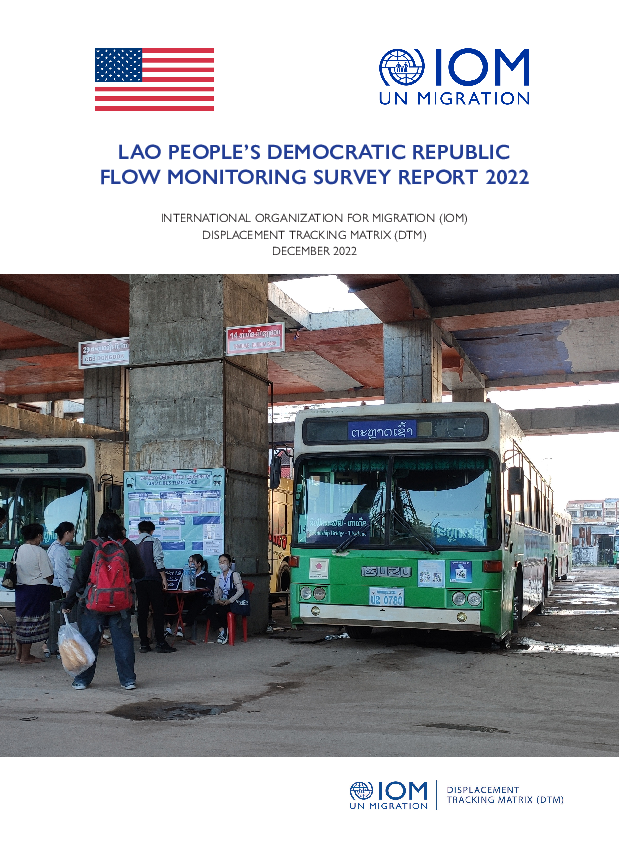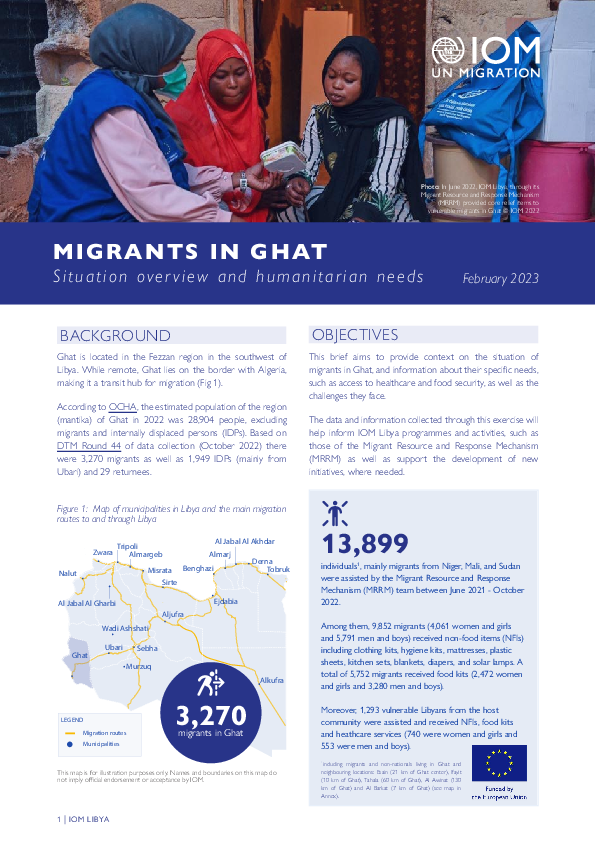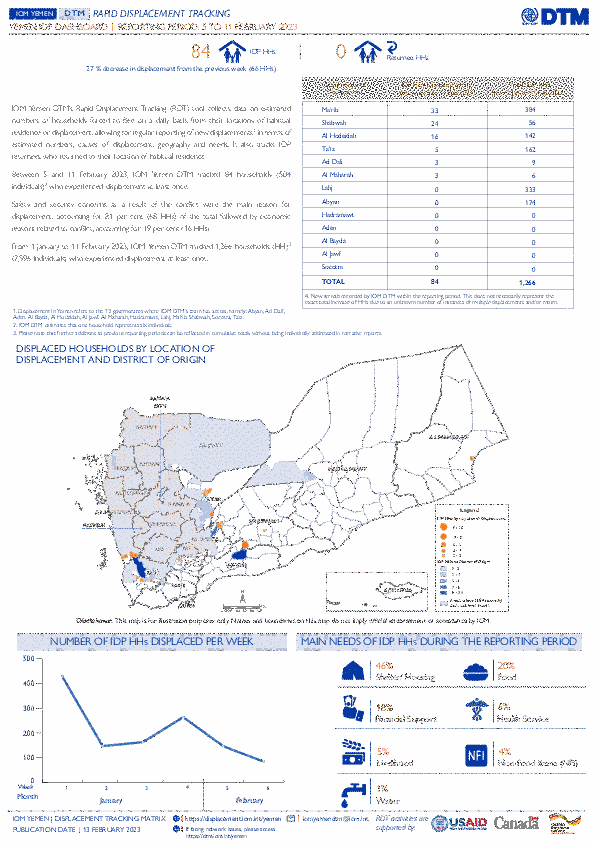-
Countries
-
Data and Analysis
-
Special Focus
-
Crisis Responses

Contact
iomlaopdr@iom.int
Language
English
Location
Laos
Period Covered
Sep 14 2022
Sep 29 2022
Activity
- Survey
- Flow Monitoring Survey
- Flow Monitoring
Labour migration of Lao people to Thailand is the largest international migration flow in Lao People’s Democratic Republic and is a vital livelihood means for hundreds of thousand Lao migrants and their families. The aim of this Flow Monitoring report was to gather and analyze data on key migration topics, namely migration profiles, drivers of migration, pre-migration arrangements and migration journeys, financial status, vulnerabilities, and reasons for return. Moreover, this year’s Flow Monitoring report drew comparisons with previous reports to identify key trends and changes in labour migration of Lao People to Thailand.
Data collection for this Flow Monitoring report took place between 14 to 29 September 2022 at Vientiane Central Bus Station, First Thai-Lao Friendship Bridge and on various buses that run between the two locations. Two surveys were utilized, namely (i) Inflow Survey targeting Lao labour migrants returning from Thailand after working there and (ii) Outflow Survey targeting Lao labour migrants departing to Thailand for work. The Inflow survey had 174 valid responses and the Outflow survey had 350 valid responses.

Contact
DTMUkraine@iom.int
Language
English
Location
Ukraine
Period Covered
Jan 16 2023
Jan 23 2023
Activity
- Survey
Повномасштабне вторгнення Російської Федерації в Україну, яке розпочалася 24 лютого 2022 року, спричинило безпрецедентну гуманітарну кризу, що охопила всі області країни. У період з 16 до 23 січня Міжнародна організація з міграції (МОМ) провела дванадцятий раунд репрезентативного експрес-оцінювання загального населення України для збору інформації стосовно потоків внутрішнього переміщення та мобільності, а також для оцінювання місцевих потреб. Це оцінювання загального населення є надійним джерелом для виявлення сфер із високими гуманітарними потребами та визначення цільових заходів реагування для надання допомоги населенню, що постраждало від війни. Географічне охоплення цього оцінювання покриває всю територію України, усі шість макрорегіонів (захід, схід, північ, центр, південь та місто Київ), за винятком Кримського півострова. Опитування загального населення було проведено шляхом набору випадкових телефонних номерів, завдяки чому було анонімно опитано 2 000 унікальних респондентів віком від 18 років із використанням методу автоматизованого телефонного опитування (CATI). Оцінка спирається на дані Фонду народонаселення ООН (UNFPA), які гуманітарна спільнота розглядає як базове значення щодо чисельності населення в Україні. Особи, які нині перебувають за межами України, під опитування не потрапили. Крім Опитування загального населення, офіційні дані про присутність ВПО на рівні громад в Україні доступні в Матриці відстеження переміщень — Базовому оцінюванні (раунд 20, HDX).
This Returns report in English may be accessed here.

Contact
DTM Libya, DTMLibya@iom.int
Language
English
Location
Libya
Snapshot Date
Feb 13 2023
Activity
- Other
This brief aims to provide context on the situation of migrants in Ghat, and information about their specific needs, such as access to healthcare and food security, as well as the challenges they face. The data and information collected through this exercise will help inform IOM Libya programmes and activities, such as those of the Migrant Resource and Response Mechanism (MRRM) as well as support the development of new initiatives, where needed.

Contact
DTM Yemen, iomyemendtm@iom.int
Language
English
Location
Yemen
Period Covered
Feb 05 2023
Feb 11 2023
Activity
- Rapid Emergency Registration
- Mobility Tracking
From 1 January to 11 February 2023, IOM Yemen DTM tracked 1,266 households (HH) (7,596 Individuals) who experienced displacement at least once.
Between 5 and 11 February 2023, IOM Yemen DTM tracked 84 households (504 individuals) displaced at least once. The majority of people moved into/within the following governorates and districts:
- Marib (33 HHs) – Marib City (25 HHs), Marib (5 HHs), Harib (3 HHs) districts. Most displacements in the governorate originated from Marib and Dhamar.
- Shabwah (24 HHs) – Hatib (15 HHs), Bayhan (8 HHs), Ataq (1 HH) districts. Most displacements in the governorate originated from Abyan and Al Bayda.
- Al Hodeidah (16 HHs) – Hays (11 HHs), Al Khukhah (5 HHs) districts. Most displacements in the governorate originated from Taiz and Al Hodeidah.
The majority of people moved from the following governorates and districts:
- Taiz (18 HHs) – Maqbanah (11 HHs), Al Maafer (3 HHs), Al Makha (1 HHs) districts.
- Abyan (15 HHs) – Mudiyah (15 HHs) district.
- Marib (11 HHs) – Al Jubah (4 HHs), Harib (3 HHs), Raghwan (1 HH) districts.
Contact
DTM Yemen, iomyemendtm@iom.int
Location
Yemen
Activity
- Mobility Tracking
- Event Tracking
Period Covered
Feb 05 2023 -Feb 11 2023
From 1 January to 11 February 2023, IOM Yemen DTM tracked 1,266 households (HH) (7,596 Individuals) who experienced displacement at least once.
Between 5 and 11 February 2023, IOM Yemen DTM tracked 84 households (504 individuals) displaced at least once. The majority of people moved into/within the following governorates and districts:
- Marib (33 HHs) – Marib City (25 HHs), Marib (5 HHs), Harib (3 HHs) districts. Most displacements in the governorate originated from Marib and Dhamar.
- Shabwah (24 HHs) – Hatib (15 HHs), Bayhan (8 HHs), Ataq (1 HH) districts. Most displacements in the governorate originated from Abyan and Al Bayda.
- Al Hodeidah (16 HHs) – Hays (11 HHs), Al Khukhah (5 HHs) districts. Most displacements in the governorate originated from Taiz and Al Hodeidah.
- Taiz (18 HHs) – Maqbanah (11 HHs), Al Maafer (3 HHs), Al Makha (1 HHs) districts.
- Abyan (15 HHs) – Mudiyah (15 HHs) district.
- Marib (11 HHs) – Al Jubah (4 HHs), Harib (3 HHs), Raghwan (1 HH) districts.
Population Groups
Survey Methodology
Unit of Analysis Or Observation
Type of Survey or Assessment
Keywords
Geographical Scope
Administrative boundaries with available data
The current dataset covers the following administrative boundaries

Contact
DTM Sudan; dtmsudan@iom.int
Language
English
Location
Sudan
Snapshot Date
Jan 12 2022
Activity
- Mobility Tracking
- Site Assessment
Integrated Location Assessments (ILA) are utilized to enhance and provide accurate and up-to-date information on access to services at major sites of displacement, alongside profiles of displaced and returnee populations. The purpose of these exercises is to determine a severity level of living conditions of returnees and IDPs to allow partners to better strategize for resources and operations in vulnerable areas or to mitigate risks of push/pull factors for a more specific set of coherent interventions that bridge humanitarian, recovery, and stabilisation needs.

Contact
DTM Haiti, dtmhaiti@iom.int
Language
English
Location
Haiti
Period Covered
Feb 09 2023
Feb 10 2023
Activity
- Mobility Tracking
- Event Tracking
A fire, of unknown origin, occurred on 8 February 2023 in the Site of Saint Monfort, the site hosting the most displaced people in the Metropolitan Area of Port-au-Prince (2,000 households of 7,500 IDPs according to latest DTM assessments in November 2022). As a result of this fire, 43 households made up of 176 individuals lost their shelters. These households took refuge with other households residing on the site.

Contact
DTM Nigeria, AllUsersInDTMNigeria@iom.int
Language
English
Location
Nigeria
Period Covered
Jan 30 2023
Feb 05 2023
Activity
- Mobility Tracking
- Event Tracking
The DTM Emergency Tracking Tool (ETT) is deployed to track and to collect information on large and sudden population movements, provide frequent updates on the scale of displacement and quantify the affected population when needed. As a sub-component of the Mobility Tracking methodology in Nigeria, ETT utilises direct observations and a broad network of key informants to capture best estimates of the affected population per location, enabling targeted humanitarian response planning.
Between 30 January and 05 February 2023, a total of 1,904 new arrivals were recorded in locations in Adamawa and Borno states. The new arrivals were recorded at locations in Askira/Uba, Bama, Dikwa, Gwoza, Hawul, Monguno, Ngala and Kala Balge* Local Government Areas (LGAs) of the most conflict-affected state of Borno and in Fufore, Gombi, Hong, Lamurde, Michika, Maiha, Song, Yola South and Yola North LGAs of Adamawa State.
Migration picked up significantly across the three migratory corridors in the East and Horn of Africa region in 2022, thus marking the end of the impact of COVID-19-related restrictions on mobility flows. Migration along the Eastern Route, which runs from the Horn of Africa to the Arabian Peninsula, mostly to the Kingdom of Saudi Arabia, increased by 64 per cent between 2021 and 2022 (from 269,000 to 441,000 migrant movements). The number of children travelling alone doubled in the last year (from 7,300 to 14,900) and these unaccompanied children represented 38 per cent of all children tracked in 2022 (39,700). Similarly, the number of female migrants travelling along the Eastern Route also doubled (from 53,200 to 106,700).
The Eastern Route, which runs from the Horn of Africa to the Arabian Peninsula, in particular to the Kingdom of Saudi Arabia, has long been the busiest and most relevant migratory corridor in the East and Horn of Africa region. In 2021, movement trends along the Eastern Corridor have significantly increased by 71% compared to 2020, suggesting that migration seems to be slowly resuming to pre-pandemic levels. However, monitored crossings from the Horn to Yemen decreased by 26% compared to 2020, although these have shown a steady but slow increase in the last quarter of 2021.


